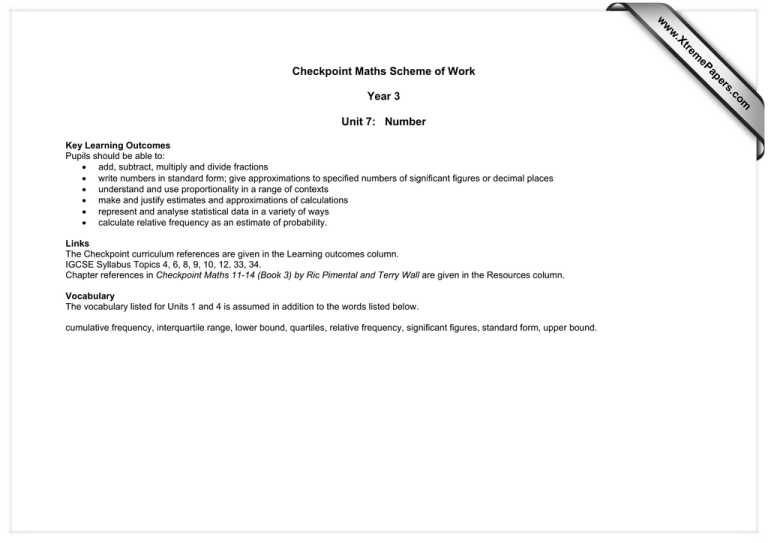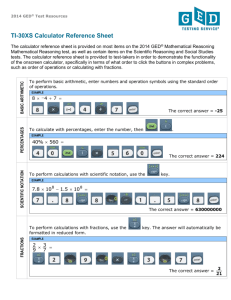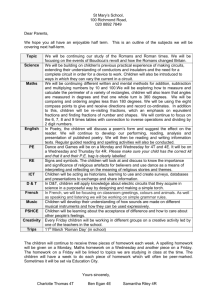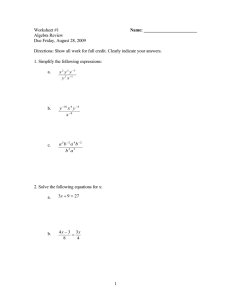Checkpoint Maths Scheme of Work Year 3 Unit 7: Number
advertisement

Key Learning Outcomes Pupils should be able to: • add, subtract, multiply and divide fractions • write numbers in standard form; give approximations to specified numbers of significant figures or decimal places • understand and use proportionality in a range of contexts • make and justify estimates and approximations of calculations • represent and analyse statistical data in a variety of ways • calculate relative frequency as an estimate of probability. Links The Checkpoint curriculum references are given in the Learning outcomes column. IGCSE Syllabus Topics 4, 6, 8, 9, 10, 12, 33, 34. Chapter references in Checkpoint Maths 11-14 (Book 3) by Ric Pimental and Terry Wall are given in the Resources column. Vocabulary The vocabulary listed for Units 1 and 4 is assumed in addition to the words listed below. cumulative frequency, interquartile range, lower bound, quartiles, relative frequency, significant figures, standard form, upper bound. om .c Unit 7: Number s er ap Year 3 eP m e tr .X w w w Checkpoint Maths Scheme of Work Learning Outcomes Np3 Use efficient methods to add, subtract, multiply and divide fractions. Write a fraction in its simplest form by cancelling common factors. Suggested Teaching Activities Revise work on fractions including the terms numerator and denominator and their meaning. Resources Study mixed numbers and illustrate with diagrams. Use practical work with sectors of circles etc. to confirm the rules for working with equivalent fractions. Provide plenty of graduated exercises on each operation with fractions, finishing with mixed examples. Np6 Ns4 Write numbers in standard form. Round numbers to a specified number of decimal places or significant figures. Understand upper and lower bounds. Use examples of very large and very small numbers to illustrate the need for standard form. Learn how to enter numbers in standard form into the calculator and how to read the displays. It can be useful to think of the EXP button on the calculator as meaning ‘times ten to the power’. Revise previous work on decimal places and significant figures and lead on to more difficult examples. Practise picking out which zeros are significant in various examples of whole numbers and decimals. Ensure that all students understand the need for zeros to show place value in whole numbers after rounding to significant figures or the nearest 100 etc. Use examples like: ‘If I owed you $245 and we agreed to round it to the nearest ten would you be happy with $25?’ ‘What needs to be done to make this correct?’ Look at upper and lower bounds in terms of linear scales by first rounding a number located on the Search for standard form at: www.learn.co.uk Checkpoint Maths 11-14 (Book 3) Chapter 6 Checkpoint Maths 11-14 (Book 3) Chapter 11 Learning Outcomes Suggested Teaching Activities scale, and then considering what other numbers would have given the same result. Resources Lead on to working the other way round by deciding which range of values could have produced a number rounded to a specified accuracy. Show that the more a number is rounded the bigger the range of values it could have arisen from. Ns3 Understand and solve problems involving proportionality. Compare two ratios. Start with simple, intuitive problems such as distance and time on a journey, conversion graphs, or recipe quantities, and progress to find formal methods of setting out the calculations. Ideas from a ratio project at: http://www.lessonplanspage.com/MathSSRatioA ndMarketing912.htm Also look at: www.illuminations.nctm.org/lessonplans/68/PoolTable/index.html Interpret and use ratio in a range of contexts. Checkpoint Maths 11-14 (Book 3) Chapter 8 Ns6 Without using a calculator estimate calculations by rounding numbers to 1 significant figure and multiplying or dividing mentally. Use practical examples to highlight the need for quick mental calculations including, for example, shopping lists or estimates of building materials or the amount of time needed for a journey. Ns5 Use an electronic calculator efficiently and appropriately to perform complex calculations with numbers of any size, including numbers expressed in standard form Start with simple revision examples, including how to enter numbers in standard form. Progress to more complex examples. Know not to round during intermediate steps of a calculation; use the sign change and π keys. Look for lessons at: http://education.ti.com/ http://pegasus.cc.ucf.edu/~ucfcasio/casio.htm Experiment with approximating numbers too early in a calculation. See how it affects the result. Learning Outcomes Nd1 Collect and tabulate discrete and continuous data, choosing suitable class intervals where appropriate. Select, construct and modify suitable graphical representation of data, including frequency polygons and cumulative frequency diagrams. Examine critically the results of a statistical enquiry and draw conclusions. Suggested Teaching Activities For example, collect data on heights of students in different year groups (boys and girls separately) or on the month and year of their birth. Resources Ideas from Adventures in Statistics at: http://www.mathforum.org/trscavo/statistics/conte nts.html Checkpoint Maths 11-14 (Book 3) Chapter 24 Use appropriate class limits for the heights and illustrate the results in different ways. Compare the data for boys and girls or for different year groups. Decide on suitable diagrams to illustrate the birth months and years and draw conclusions from the results. Nd2 Find the median and quartiles; estimate the mean, median and interquartile range of a set of grouped data. Use the data already collected. http://www.mste.uiuc.edu/hill/dstat/dstatintro.html Nd3 Know that the sum of probabilities of all mutually exclusive outcomes is 1 and use this when solving problems. Collect examples of mutually exclusive outcomes. Where possible calculate their respective probabilities to demonstrate that they add up to one in each case. Use this property to solve problems. Look for ideas at: www.mathgoodies.com/lessons/toc_vol6.html Understand relative frequency as an estimate of probability and use this to compare outcomes of experiments in a range of contexts. Experiment with practical work, tossing a coin, picking beads out of a bag etc. and predict the results. If possible experiment with biased dice to find which number they favour.



